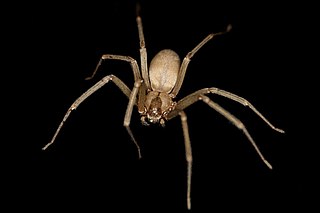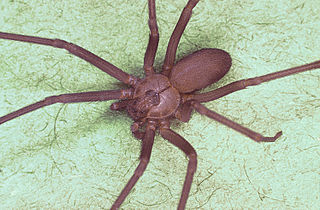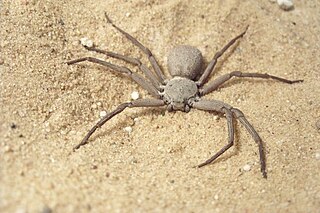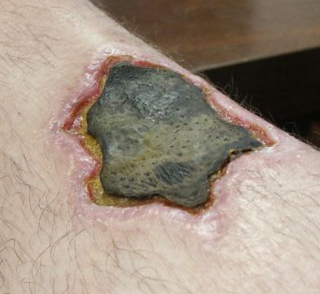
The brown recluse, Sicariidae is a recluse spider with necrotic venom. Similar to those of other recluse spiders, their bites sometimes require medical attention. The brown recluse is one of three spiders in North America with medically significant venom, the others being the black widow and the Chilean recluse.

The spider family Liphistiidae, recognized by Tamerlan Thorell in 1869, comprises 8 genera and about 100 species of medium-sized spiders from Southeast Asia, China, and Japan. They are among the most basal living spiders, belonging to the suborder Mesothelae. In Japan, the Kimura spider is well known.

The recluse spiders, also known as brown spiders, fiddle-backs, violin spiders, and reapers, is a genus of spiders that was first described by R. T. Lowe in 1832. They are venomous spiders known for their bite, which sometimes produces a characteristic set of symptoms known as loxoscelism.

Sicariidae is a family of six-eyed venomous spiders known for their potentially necrotic bites. The family consists of three genera and about 160 species. Well known spiders in this family include the brown recluse spider and the six-eyed sand spider.

The Pholcidae are a family of araneomorph spiders. The family contains over 1,800 individual species of pholcids, including those commonly known as cellar spider, daddy long-legs spider, carpenter spider, daddy long-legger, vibrating spider, gyrating spider, long daddy, and skull spider. The family, first described by Carl Ludwig Koch in 1850, is divided into 94 genera.

The Mediterranean recluse spider is a species of spider that originated in the Mediterranean region as its name implies, but can now be found in many parts of the world and is listed as one of the most invasive spiders world-wide. Usually dwelling in caves, the spiders will also inhabit basements and tunnels. Their webs shelter their egg sacs, which hatch into young that molt as they grow. The spider hunts at night and eats species including silverfish and cockroaches, and they usually target smaller insects.
Zebra is the American medical slang for arriving at a surprising, often exotic, medical diagnosis when a more commonplace explanation is more likely. It is shorthand for the aphorism coined in the late 1940s by Theodore Woodward, professor at the University of Maryland School of Medicine, who instructed his medical interns: "When you hear hoofbeats behind you, don't expect to see a zebra." By 1960, the aphorism was widely known in medical circles.

A spider bite, also known as arachnidism, is an injury resulting from the bite of a spider. The effects of most bites are not serious. Most bites result in mild symptoms around the area of the bite. Rarely they may produce a necrotic skin wound or severe pain.

Sicarius is a genus of recluse spiders that is potentially medically significant to humans. It is one of three genera in its family, all venomous spiders known for a bite that can induce loxoscelism. They live in deserts and arid regions of the Neotropics, and females use a mixture of sand and silk when producing egg sacs. The name is Latin for assassin.

The Chilean recluse spider, Loxosceles laeta, is a highly venomous spider of the family Sicariidae. In Spanish, it is known as araña de rincón, or "corner spider"; in Brazilian Portuguese, as aranha-marrom or "brown spider". It is considered by many to be the most dangerous of recluse spiders, and its bites often result in serious systemic reactions, up to and including death.

Loxoscelism is a condition occasionally produced by the bite of the recluse spiders. The area becomes dusky and a shallow open sore forms as the skin around the bite dies (necrosis). It is the only proven type of necrotic arachnidism in humans. While there is no known therapy effective for loxoscelism, there has been research on antibiotics, surgical timing, hyperbaric oxygen, potential antivenoms and vaccines. Because of the number of diseases that may mimic loxoscelism, it is frequently misdiagnosed by physicians.

Coneweb spiders (Diguetidae) are six-eyed haplogyne spiders that live in tangled space webs, fashioning a cone-like central retreat where they hide and lay eggs. It is a small family, containing only two genera with fifteen species and is confined to the New World, preferring deserts. Members of the genus Diguetia usually build their webs in shrubs or between cactus pads. They have the same eye arrangement as the venomous recluse spiders, but none are known to be harmful to humans.

Spiders are air-breathing arthropods that have eight legs, chelicerae with fangs generally able to inject venom, and spinnerets that extrude silk. They are the largest order of arachnids and rank seventh in total species diversity among all orders of organisms. Spiders are found worldwide on every continent except for Antarctica, and have become established in nearly every land habitat. As of August 2022, 50,356 spider species in 132 families have been recorded by taxonomists. However, there has been debate among scientists about how families should be classified, with over 20 different classifications proposed since 1900.

"The Recluse" is the fourth single from Plan B's second album The Defamation of Strickland Banks. The single was released on 4 October 2010. "The Recluse" has been labeled as "one of his best singles to date" by critics, "neatly marrying poignancy and aggression into a 4-minute-long track with a surplus of scaling strings and his voice showing more desperation for release than ever before." This song was covered by George Michael during his "Symphonica" tour.

Loxosceles deserta, commonly known as the desert recluse, is a recluse spider of the family Sicariidae. It is found in Mexico and the United States.
The pathophysiology of a spider bite is due to the effect of its venom. A spider envenomation occurs whenever a spider injects venom into the skin. Not all spider bites inject venom – a dry bite, and the amount of venom injected can vary based on the type of spider and the circumstances of the encounter. The mechanical injury from a spider bite is not a serious concern for humans. Some spider bites do leave a large enough wound that infection may be a concern. However, it is generally the toxicity of spider venom that poses the most risk to human beings; several spiders are known to have venom that can cause injury to humans in the amounts that a spider will typically inject when biting.

Titiotus is a genus of American false wolf spiders that was first described by Eugène Louis Simon in 1897.

Hexophthalma is a genus of spiders in the family Sicariidae. Although the genus was originally erected in 1878, it was merged into the genus Sicarius in the 1890s, and remained unused until revived in 2017, when it was discovered that the African species then placed in Sicarius were distinct. The English name six-eyed sand spiders is used for members of the genus, particularly Hexophthalma hahni. Species in the genus have necrotic (dermonecrotic) venom, and can potentially cause serious or even life-threatening wounds.















